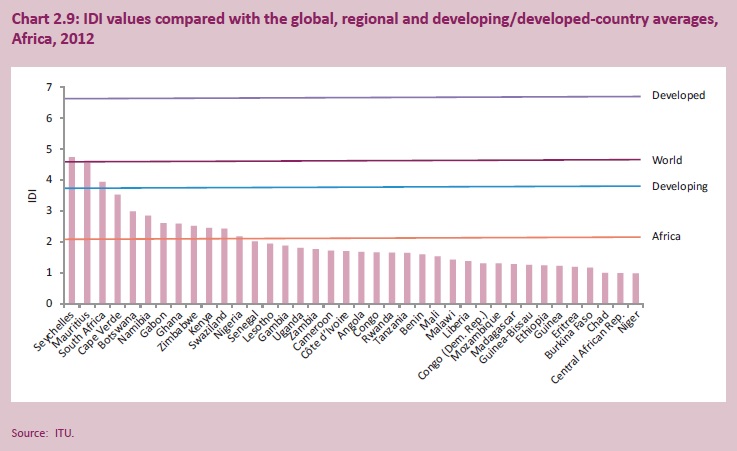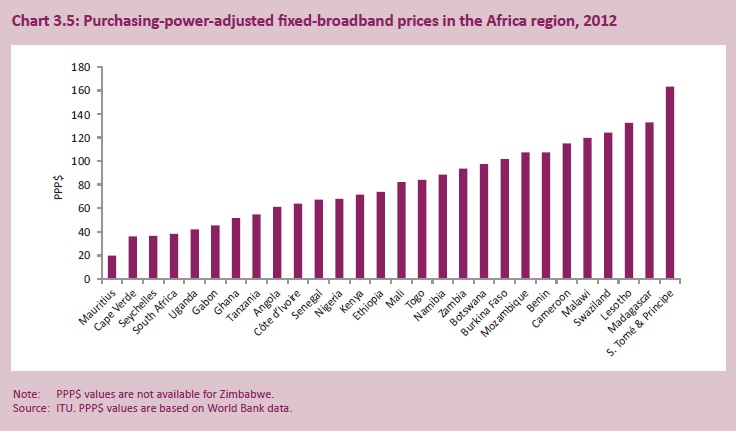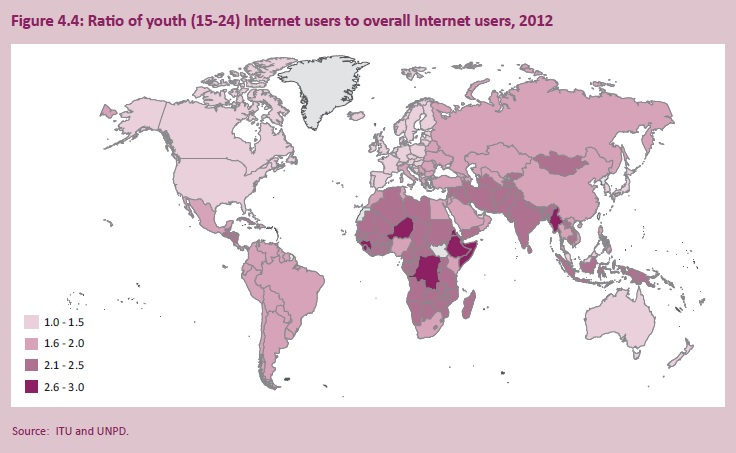African internet and broadband facts from ‘Measuring the Information Society 2013’ report
The International Telecommunications Union (ITU), regarded as a prime source for Internet statistics, has released a detailed report on Internet usage habits in 157 countries around the world. Similar to previous years, Measuring the Information Society 2013 serves to gauge how developed and developing nations compare in terms of overall information communication technology adoption. Of interest to many is the ICT Development Index which ranks nations by number of subscriptions, type of subscription, broadband availability, and cost of access. This ranking only goes so far, however, and the value of comparing African ICT benchmarks with global stats is marginal since nearly all African nations lag developed counterparts in terms of ICT access, ICT use, and ICT prices.
At a global level, the report finds that 250 million additional people came online in 2012. By the end of this year, 40% of the world will be online. Mobile voice coverage is available to most people globally (and 3G to half) and mobile broadband is more affordable than fixed broadband. In addition, 30% of the world’s youth are online.
Stepping away from the ICT Development Index (IDI) and global findings, key themes found in developing nations include lowering the cost of broadband and stressing how youth are a large portion of internet users. Also, mobile broadband is still not in a position to replicate the successful growth of cellular subscriptions. Prices must go down even further if marginalized groups are to consistently go online. For the 5th year in a row, mobile broadband services in developing countries have experienced strong annual growth in terms of both adoption and reduced costs. Fixed broadband prices have dropped by a large percentage as well but are still expensive. Typical broadband service in Africa (if there is such a thing) costs a staggering 64% of gross national income per capita.
Below are some of the granular findings from the full report that best describe how African nations stack up globally in terms of ICT development, how unaffordable broadband is in Africa, who is more likely to use the internet, and which nations are experiencing the greatest improvements in ease of access.
- An estimated 16.3% of individuals use the internet in Africa.
- An estimated 10.9% of Africans have an active mobile broadband subscription.
- An estimated 0.3% of Africans have a fixed (wired) broadband subscription.
- An estimated 6.7% of African households have internet access.
- The ratio of households with internet access and households has improved to 1:1.5 as mobile devices are used to connect at home.
- Nearly 10% of African youth aged 15-24 years have five or more years of online experience.
- Seychelles, Zambia, and Zimbabwe as ‘most dynamic countries’ that have improved their ICT development rank in the past year.
- Seychelles: 47% use the internet, fixed penetration is at 12%, international bandwidth almost tripled in 2012 with the SEAS cable landing.
- Zambia: Mobile cellular penetration rose from 61% in 2011 to 76% in 2012. Policy makers are focusing on rural connectivity, including power issues and better mobile coverage.
- Zimbabwe: Mobile cellular penetration rose from 72% in 2011 to 97% in 2012. Wireless broadband penetration doubled over the same period. Rural infrastructure projects and m-banking made progress.
- In Cameroon, Djibouti, Rwanda, and Togo, fewer than one in ten people use the Internet.
- In Eritrea and Niger, fewer than 2% of the population is online.
- Chad, Central African Republic, and Niger had not launched 3G services by the end of 2012 (CAR now has 3G, however).
- Countries with relatively high income levels but comparatively lower IDI values include Angola, Gabon, and Botswana. In these countries, focused policies and government action could quickly lead to higher ICT levels.
- In 2012, only few economies, such as Eritrea, Ethiopia, Mozambique and Niger, recorded mobile cellular penetration rates of around 30 per cent or less.
- A number of landlocked developing countries, such as the Central African Republic and Chad, continue to suffer from very low levels of international connectivity. Kenya and South Africa have benefited from new cable deployments, and public-private partnerships to distribute them.
- In Burkina Faso, Democratic Republic of the Congo, and Liberia, fewer than 5 per cent of households have a computer.
- In Mali and Rwanda, fewer than 3 per cent of households have Internet access at home.
- Kenya has the largest amount of international internet bandwidth per internet user in Africa (24 kbit/s per user). South Africa follows at 19 kbit/s, Cote d’Ivoire 17 kbit/s, Seychelles 17 kbit/s, Mauritius 15 kbit/s.
- In Sudan, the number of households with a computer and with Internet access increased substantially between 2011-2012, from 11 to 14 per cent and from 21 to 29 per cent, respectively.
- In 2012 the Central African Republic reported that fixed (wired)-broadband services had been suspended and that WiMAX was the only operational broadband service in the country, which also suffers from a lack of international Internet bandwidth.
- In Mauritius, wireless broadband penetration grew by 73%, to 22 per 100 inhabitants in 2012.
- Between 2011 and 2012, Africa was the region where the coefficient of variation value increased the most, implying a widening of the regional digital divide. The region’s top IDI countries (including Seychelles, Mauritius, South Africa and Cape Verde) continue to make good progress in terms of ICT development, while the countries at the bottom (including Central Africa Republic, Burkina Faso, Guinea and Ethiopia) are failing to keep pace both regionally and globally.
- Seychelles and Mauritius are the only African countries with an IDI above the global average.
- Niger falls at the bottom in terms of ICT Development Index.
- Between 2011 and 2012, more African countries moved up than moved down the global rankings. Moreover, countries that lost ground in the global IDI fell by no more than two places.
- Eight African countries had achieved more than 100 per cent mobile-cellular penetration by end 2012.
- Eritrea has the lowest penetration rate worldwide, at just 5 per cent at end 2012, and showed very little growth from 2011.
- In Botswana, Côte d’Ivoire, and Ethiopia, international Internet bandwidth per Internet user has actually decreased, not because there was a reduction in the international bandwidth, but because the number of Internet users increased faster than the amount of bandwidth.
- Only the Seychelles (12%) and Mauritius (10.5%) have notable fixed (wired)-broadband penetration rates.
- Highest percentages of individuals using the internet: 47% in Seychelles, 41% in Mauritius. South Africa (41%), Cape Verde (35%), Nigeria (33%), and Kenya (32%).
- In Eritrea, Ethiopia, Guinea, and Niger, internet penetration stood at around 1 per cent by end 2012.
- African fixed broadband prices are, on average, 64% of GNI per capita but are below 5% of GNI per capita in Seychelles, Mauritius, Gabon, and South Africa.
- In Niger, fixed broadband costs 210% of GNI p.c.
- Countries that have direct connections to WACS and ACE cables could see fixed broadband prices drop significantly, provided that local ISPs can benefit from competitive prices when they connect to the international gateways.
- In all six ITU regions, 500 MB postpaid handset based plans are the most affordable, at below 6% of GNI p.c., except for Africa, where the price exceeds 36% of GNI p.c.
- Mobile-broadband prices are least affordable in the African LDCs Democratic Republic of the Congo, Niger, Sierra Leone and Sao Tome and Principe, as well as Zimbabwe. In these countries, the cost of mobile-broadband services exceeds monthly GNI p.c.
- Handset-based offers at 500 MB (both prepaid and postpaid) cost less than 1.5 per cent of GNI p.c. in Tunisia. Here, 1 GB prepaid offers can be had for as low as 2.1% of GNI p.c.
- In the African low-income country Kenya mobile-broadband prices, though still high, are relatively affordable in comparison with other countries in the region.
- Egypt stands out among the Arab States in particular for its affordable prepaid and postpaid computer-based mobile broadband offers at around 2 per cent of GNI p.c.
- Africa is the region that has the biggest proportion of countries where postpaid computer-based mobile-broadband prices are less expensive than fixed-broadband prices. Currently, mobile broadband is cheaper than fixed broadband in two-thirds of African countries included in the comparison, and thus constitutes a genuine alternative to fixed broadband in terms of price.
- In Egypt, the 1 GB mobile-broadband plan is more affordable than the fixed-broadband plan. The same is true in Nigeria, although the fixed-broadband plan includes a higher amount of data (6 GB) compared with the 1 GB postpaid computer-based mobile-broadband plan. In contrast to this, in South Africa the 1 GB fixed broadband plan is more affordable than the 1 GB computer-based mobile-broadband plan.
- In Africa, Mauritius, which ranks first in the regional IDI, also has the highest percentage of digital natives (15-24 years who have five or more years of online experience). Second is Zimbabwe, where 6.1 per cent of the population are digital natives in 2012.
- In Central African Republic, Democratic Republic of the Congo, Eritrea, Ethiopia and Niger, fewer than 0.4% of the population is a ‘digital native.’
- Youth in Africa are 2.3x as likely to use the internet as the overall population (higher than any other region).
- The youth bulge in Africa and developing economies should be a core driver of the level of digital nativism in those countries.
Interested in last year’s MIS report? Our summary can be found here.















 Twitter
Twitter Facebook
Facebook Pinterest
Pinterest
[…] OAfrica reports that only 10% of African youth aged 15-24 years have five or more years of online experience. […]